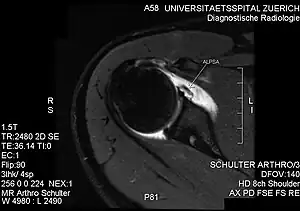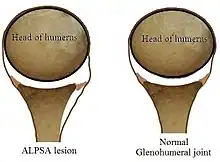ALPSA lesion
| ALPSA lesion | |
|---|---|
 | |
| PD-weighted MRI with fat saturation of the shoulder showing an ALPSA lesion | |
An ALPSA (anterior labral periosteal sleeve avulsion) lesion is an injury at the front of the shoulder associated with shoulder dislocation.[1]
Signs and symptoms
Associated condition
ALPSA lesion is associated with shoulder separation[1]
Anatomy
The shoulder joint is made up of the glenoid and humeral head. The humeral head is ball-shaped but the glenoid is more dish-shaped than cup-shaped. To aid stability of the joint, the glenoid has a soft tissue bumper around its edge (the labrum) which acts as a bumper preventing dislocation of the head from the glenoid.
Pathology
The anterior (front) labrum can peel off the glenoid resulting in a Bankart lesion. When the periosteum (fibrous tissue surrounding bone) peels off as well this is called an ALPSA lesion. When this happens the labrum (bumper) falls away and rolls up. It normally falls medially and downwards.

Diagnosis
The evaluation of ALPSA lesions are done via magnetic resonance angiography and arthroscopy[2]

Treatment
If required, the labrum and periosteum can be reattached, recreating the bumper affect, aiding shoulder stability and hopefully preventing further dislocation. It can be done by Arthroscopic techniques or with open surgery. The injury cannot always be repaired.
References
- 1 2 Gaillard, Frank. "Anterior labroligamentous periosteal sleeve avulsion lesion | Radiology Reference Article | Radiopaedia.org". Radiopaedia. Archived from the original on 16 July 2020. Retrieved 15 July 2020.
- ↑ Kim, Doo Sup; Yoon, Yeo Seung; Kwon, Sung Min (2010). "The Spectrum of Lesions and Clinical Results of Arthroscopic Stabilization of Acute Anterior Shoulder Instability". Yonsei Medical Journal. 51 (3): 421. doi:10.3349/ymj.2010.51.3.421. Archived from the original on 5 March 2023. Retrieved 5 March 2023.